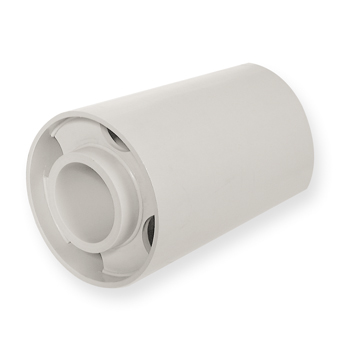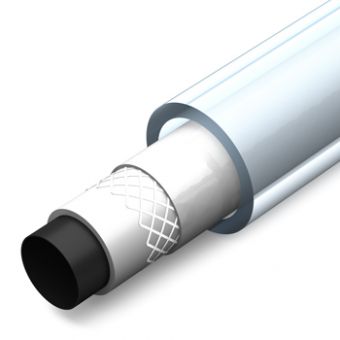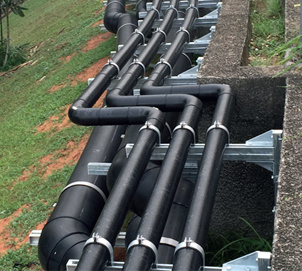Systems Available
DuoSafe Rigid System
 The Rigid system in PVCU & PVCC is basically a 15-bar rated inner pipe, suspended inside a 9-bar rated outer pipe by 5 special clips on centralisers, and is a solvent weld system.
The Rigid system in PVCU & PVCC is basically a 15-bar rated inner pipe, suspended inside a 9-bar rated outer pipe by 5 special clips on centralisers, and is a solvent weld system.
Solvents to be used are the 724 cement with P70 Primer, and are required for all double contained solvent systems, as it is the only cement available to handle hazardous chemicals.
The pipe is not fixed, and can be disassembled for installation and cutting purposes.
The fittings are all free floating (not fixed rigid inside each other) although Terminations, zone fittings are fixed, and some fittings although free floating design cannot be disassembled. Full installation instructions can be found further down this section, but a new addition in the shape of an installation bush does not appear. In the Handbook section you will see the installation bush. This is to help in the installation of elbows and tees, by centralising the fitting before attempting to solvent weld it to a pipe. The bush goes into the end of the fitting not being welded, and keeps it from moving back and forth, while allowing an up and down motion, so the inner fitting can be located onto the pipe. Once the weld is done, you can remove it
Fittings
There is a full range of fittings available like tees, elbows etc, and valves are available in boxes as per the flex system, or can be supplied in pressure rated tees.
Zone Fittings
This system has a true zone fitting, and can be fit anywhere in the system, but in conjunction with a Visual leak detection fitting, the leak detect must be fit at the lowest point in the zone. There is an ISO drawing later in this section, to give an idea of how fittings may be placed. These are a socket within a socket, and has the containment blocked off to allow any liquid to stay in the zone designated.
Leak detection
Leak detection fittings come in two styles; the first is a standard tee, reduced on the branch to 1", and comes with 1ft of 1" clear pipe and a lockable valve. This can be fit to the pipe work as its being installed. The other is a clamp saddle with fittings, pipe and valve as per the first option, and these can be fit after the pipework has been installed. Once again these are visual only but can be made to take a mechanical or electrical detect fitting (not supplied by IPS).
Closure Fitting
This is a special machine fitting and used only when you have installed pipework from both start and finish points, and are then connecting two fixed points.
Where two fixed points are encountered, it is impossible to make both inner and outer joints together. Movement must be available to make both the inner joints, but then the closure fitting is used so both joints can be made to the outer pipe. A full description can be found in the Installation Guide further down this section.
AgruSafe & Polyflo PP and PE
Agru manufacture two system in double containment. The first is Polyflo and the second is Agrusafe.
PolyFlo covers sizes 32mm x 50mm, 63mm x 90mm and 110mm x 160mm, the AgruSafe covers the larger sizes in 160mm x 280mm, 200mm x 315mm and 250mm x 355mm although larger sizes are available on request.
The two systems differ in manufacture and in installation techniques, so below are differences and explanations of fittings that can be found in the handbook pages further down this section.

Polyflo
 The PolyFlo system is a twin wall rigid system, co extruded as a singular item, with fittings extruded in the same way.
The PolyFlo system is a twin wall rigid system, co extruded as a singular item, with fittings extruded in the same way.
All fittings are extruded longer length on the inner, to allow machining in welding machine back to virgin material, but also to allow match up on wall sizes before welds take place.
Welding is a standard butt fusion technique, although special welding parameters are required as the inner weld is the most important to get correct. Please see further down in this section.
The system has all of the usual fittings such as tees, 45-degree elbows, and 90-degree elbows manufactured from 45-degree elbows, but it also has dedicated reducers unlike the solvent weld system.
Other Fittings are available, which are listed below with an explanation of their use: -
Fixed point and restrained fixed point
These fittings are classed as a Zone fitting as they isolate the containment, so like the Solvent Weld system, these can be put anywhere in the system to zone off areas of the pipework, and are inline pipe to pipe connections. As discussed in other systems, this directs the leak towards a leak detection fitting. The restrained version, has a cut out on the circumference of the fitting, to allow a clip to be fixed to the recess, to fix that point in the pipework rigid in the system, stopping that part from moving and allowing the expansion of the pipework, to move away from that point in either direction. There is another restrained fitting that CONTINUES the containment if required.
Outer Wall and Termination fitting
The outer wall fitting will connect to the branch of a tee, and blanks off the branch of the inner pipe, but allows the outer pipe of the branch to be open. This can then be used as a leak detection patch, by butt fusing to this.
The Termination fitting connects to both inner and outer, and terminates the outer pipework, while leaving a spigot butt fusion joint for the inner.
Leak Detection Fittings
There are three versions of these fittings, and they all have the same leak detection connection in the shape of a 25mm union nut connection (1 ¼" FBSP).
Versions are inline Pipe to Pipe connection, but with a leak path from one side only, so in theory can be used as a zone fitting as well; inline pipe to pipe connection, but with a leak path coming from both sides? and lastly a termination fitting, so connection to double containment, with leak path, but reduced to single butt fusion spigot for connection to regular singular pipe.
Instrumentation Fitting
Connection is inline pipe to pipe connection, but with a plain connection directly to the inner line for connection of a gauge, for example.
Flanges
There are three styles of flange, but the backing ring to suit them will always be the size of the outer pipe.
The first is the Termination stub flange; this terminates the containment, and leaves a flange connection based on the outer sized pipe.
The second can be twinned with the third option; - second option has two O rings in the face and allows the containment to carry on through the face of the flange. The Third option has the containment through the flange, but because its flat faced, it will seal against the O rings to create the seaI.
AgruSafe
 The AgruSafe system is very much like the PolyFlo system, but the outer pipe is much larger in relation to the inner pipe, as the fittings must be of a size to accept the inner fitting with ease.
The AgruSafe system is very much like the PolyFlo system, but the outer pipe is much larger in relation to the inner pipe, as the fittings must be of a size to accept the inner fitting with ease.
All fittings come from the manufacturer assembled and welded in place using support discs (shown in the handbook section further down this section), and apart from preparation in the welding machine, are ready to weld.
Pipe is also welded together ready to use, and utilises two support discs either end welded into position on the inner and outer pipe, and supported down the length with clip on spider clips 4 per length.
Pipe can be cut to size on site, but for each cut it is recommended to take 2 support discs and 1 spider clip. The discs are positioned into the ends of the pipe, set back a little to allow for planning of the pipe in the welding machine, and then welded the circumference of the inner pipe to the disc, and the four points of the disc to the inner bore of the outer pipe. This is done with a handheld hot gas air gun and welding wire.
This will reinstate both pieces of pipe after the cut is made. The spider clip is in case further support for the inner pipe is required in one of the cut pieces of pipe, and must be fit prior to welding the support discs.



